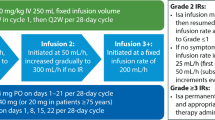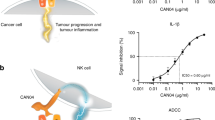Abstract
The optimal schedule for recombinant interleukin-2 (rIL-2) administration is unclear. Because the clinical and immunological effects of prolonged continuous exposure to rIL-2 are unknown, we have conducted a phase I study to assess the toxicity and feasibility of continuous low dose infusion of rIL-2 (EuroCetus) using central venous access with a portable infusion device on an out-patient basis. Twenty-two patients entered the study, 13 with melanoma and nine with renal cell cancer, age range 26-66 years (median 51), performance status less than or equal to 1. They were treated with one of the following doses per m2 per 24 h: 0.18 x 10(6) IU, 0.6 x 10(6) IU, 1.8 x 10(6) IU, 3 x 10(6) IU, 6 x 10(6) IU and 9 x 10(6) IU. Toxicity was evaluable in 20 patients receiving greater than or equal to 3 weeks treatment duration or in whom treatment was discontinued prematurely because of toxicity. Constitutional symptoms consisting of fatigue, malaise and fever up to 40 degrees C without significant organ dysfunction occurred with doses greater than or equal to 1.8 x 10(6) IU m-2. The maximum tolerated dose was 6 x 10(6) IU m-2 24 h-1. In all patients toxicity reached a peak at 3 weeks and resolved thereafter despite continued rIL-2 treatment. Peripheral blood eosinophilia (up to 66% of white blood cell count) followed the same pattern. An infection of the central venous access occurred in 55% of the patients but this was mostly asymptomatic. Thirteen patients were treated greater than or equal to 6 weeks and were evaluable for tumour response. A partial remission occurred in a patient with melanoma with a dose of 1.8 x 10(6) IU rIL-2 m-2 24 h-1.
This is a preview of subscription content, access via your institution
Access options
Subscribe to this journal
Receive 24 print issues and online access
$259.00 per year
only $10.79 per issue
Buy this article
- Purchase on Springer Link
- Instant access to full article PDF
Prices may be subject to local taxes which are calculated during checkout
Similar content being viewed by others
Author information
Authors and Affiliations
Rights and permissions
About this article
Cite this article
Vlasveld, L., Rankin, E., Hekman, A. et al. A phase I study of prolonged continuous infusion of low dose recombinant interleukin-2 in melanoma and renal cell cancer. Part I: Clinical aspects. Br J Cancer 65, 744–750 (1992). https://doi.org/10.1038/bjc.1992.157
Issue Date:
DOI: https://doi.org/10.1038/bjc.1992.157
This article is cited by
-
Treatment of low-grade non-Hodgkin's lymphoma with continuous infusion of low-dose recombinant interleukin-2 in combination with the B-cell-specific monoclonal antibody CLB-CD19
Cancer Immunology Immunotherapy (1995)
-
Possible role for cytotoxic lymphocytes in the pathogenesis of acute interstitial nephritis after recombinant interleukin-2 treatment for renal cell cancer
Cancer Immunology, Immunotherapy (1993)



